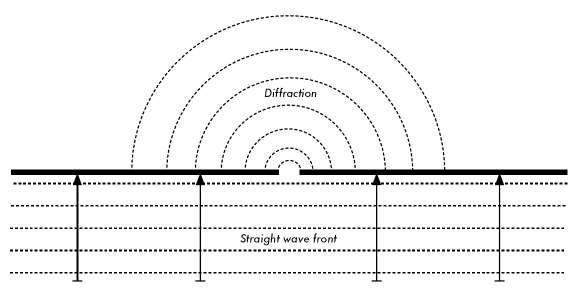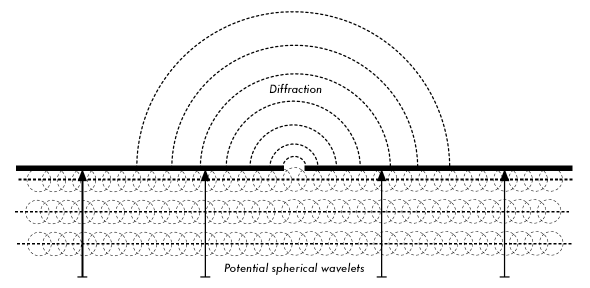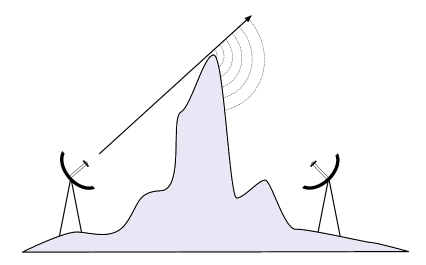| Wireles Networking is a practical guide to planning and building low-cost telecommunications infrastructure. See the editorial for more information.... |

|

Home  A Practical Introduction to Radio Physics A Practical Introduction to Radio Physics  Behavior of Radio Waves Behavior of Radio Waves  Diffraction Diffraction |
|||||||
| See also: Absorption, Reflection, Interference | |||||||






|
|||||||
|
DiffractionDiffraction is the apparent bending of waves when hitting an object. It is the effect of “waves going around corners”. Imagine a wave on water traveling in a straight wave front, just like a wave that we see rolling onto an ocean beach. Now we put a solid barrier, say a wooden solid fence, in its way to block it. We cut a narrow slit opening into that wall, like a small door. From this opening, a circular wave will start, and it will of course reach points that are not in a direct line behind this opening, but also on either side of it. If you look at this wavefront -and it might just as well be an electromagnetic wave -as a beam (a straight line), it would be hard to explain how it can reach points that should be hidden by a barrier. When modeled as a wavefront, the phenomenon makes sense.
The Huygens Principle provides one model for understanding this behavior. Imagine that at any given instant, every point on a wavefront can be considered the starting point for a spherical “wavelet”. This idea was later extended by Fresnel, and whether it adequately describes the phenomenon is still a matter of debate. But for our purposes, the Huygens model describes the effect quite well.
Through means of the effect of diffraction, waves will “bend” around corners or through an opening in a barrier. The wavelengths of visible light are far too small for humans to observe this effect directly. Microwaves, with a wavelength of several centimeters, will show the effects of diffraction when waves hit walls, mountain peaks, and other obstacles. It seems as if the obstruction causes the wave to change its direction and go around corners.
Note that diffraction comes at the cost of power: the energy of the diffracted wave is significantly less than that of the wavefront that caused it. But in some very specific applications, you can take advantage of the diffraction effect to circumvent obstacles.
|
|||||||
Home  A Practical Introduction to Radio Physics A Practical Introduction to Radio Physics  Behavior of Radio Waves Behavior of Radio Waves  Diffraction Diffraction |
|||||||
Last Update: 2007-01-24




